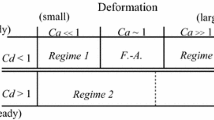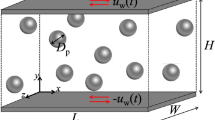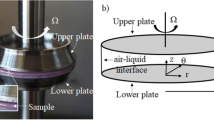Abstract
This work investigates transient non-colloidal suspension flows in cone-and-plate, plate-plate, and cylindrical geometries to assess particle motion’s impact on viscosity measurement. Mass and momentum conservation equations model the two-phase liquid–solid flow, with both phases treated as continuous in an Euler-Euler approach. Findings demonstrate rheometric flow induces particle motion, affecting suspension homogeneity and viscosity measurement over time. Both buoyancy and inertia effects drive particle motion, with buoyancy dominating at low shear rates and inertia at high shear rates. Particle volume fractions, shear rates, and liquid viscosity notably influence viscosity measurements. Measurements with concentric cylinders are the least affected by particle motion. Additionally, we propose a time limit and a critical Reynolds number in which particle motion does not affect the measurement of the suspension viscosity.











Similar content being viewed by others
References
ANSYS Inc. (2019). CFX-Solver Manager User’s Guide
Auton T (1987) The lift force on a spherical body in a rotational flow. J Fluid Mech 183:199–218
Barth T, Jespersen D (1989) The design and application of upwind schemes on unstructured meshes. In: 27th Aerospace sciences meeting p 366
Chapman B, Leighton D Jr (1991) Dynamic viscous resuspension. Int J Multiphase Flow 17:469–483
Chow AW, Sinton SW, Iwamiya JH, Stephens TS (1994) Shear-induced particle migration in Couette and parallel-plate viscometers: NMR imaging and stress measurements. Phys Fluids 6:2561–2576
Corbett AM, Phillips RJ, Kauten RJ, McCarthy KL (1995) Magnetic resonance imaging of concentration and velocity profiles of pure fluids and solid suspensions in rotating geometries. J Rheol 39:907–924
Enwald H, Peirano E, Almstedt A-E (1996) Eulerian two-phase flow theory applied to fluidization. Int J Multiphase Flow 22:21–66
Fall A, Lemaitre A, Bertrand F, Bonn D, Ovarlez G (2010) Continuous and discontinuous shear thickening in granular suspension. Phys Rev Lett 105:268303
Fall A, Lemaitre A, Bertrand F, Bonn D, Ovarlez G (2010) Shear thickening and migration in granular suspensions. Phys Rev Lett 105:268303
Gadala-Maria F, Acrivos A (1980) Shear-induced structure in a concentrated suspension of solid spheres. J Rheol 24:799–814
Gamonpilas C, Morris JF, Denn MM (2016) Shear and normal stress measurements in non-Brownian monodisperse and bidisperse suspensions. J Rheol 60:289–296
Gidaspow D (1994) Multiphase flow and fluidization: continuum and kinetic theory descriptions. Academic press
Huang N, Bonn D (2007) Viscosity of a dense suspension in Couette flow. J Fluid Mech 590:497–507
Ishii M, Hibiki T (2010) Thermo-fluid dynamics of two-phase flow. Springer Science & Business Media
Kim JM, Lee SG, Kim C (2008) Numerical simulations of particle migration in suspension flows: frame-invariant formulation of curvature-induced migration. J Non-Newtonian Fluid Mech 150:162–176
Konijn B, Sanderink O, Kruyt NP (2014) Experimental study of the viscosity of suspensions: effect of solid fraction, particle size and suspending liquid. Powder Technol 266:61–69
Krieger IM, Dougherty TJ (1959) A mechanism for non-Newtonian flow in suspensions of rigid spheres. Trans Soc Rheol 3:137–152
Krishnan GP, Beimfohr S, Leighton DT (1996) Shear-induced radial segregation in bidisperse suspensions. J Fluid Mech 321:371–393
Kulkarni PM, Morris JF (2008) Suspension properties at finite Reynolds number from simulated shear flow. Phys Fluids 20:040602
Leighton D, Acrivos A (1986) Viscous resuspension. Chem Eng Sci 41:1377–1384
Leighton D, Acrivos A (1987) The shear-induced migration of particles in concentrated suspensions. J Fluid Mech 181:415–439
Linares-Guerrero E, Hunt ML, Zenit R (2017) Effects of inertia and turbulence on rheological measurements of neutrally buoyant suspensions. J Fluid Mech 811:525–543
Maluta F, Paglianti A, Montante G (2019) Rans-based predictions of dense solid-liquid suspensions in turbulent stirred tanks. Chem Eng Res Des 147:470–482
Merhi D, Lemaire E, Bossis G, Moukalled F (2005) Particle migration in a concentrated suspension flowing between rotating parallel plates: investigation of diffusion flux coefficients. J Rheol 49:1429–1448
Moon JY, Dai S, Chang L, Lee JS, Tanner RI (2015) The effect of sphere roughness on the rheology of concentrated suspensions. J Non-Newtonian Fluid Mech 223:233–239
Mueller S, Llewellin E, Mader H (2009) The rheology of suspensions of solid particles. Proc R Soc A Math Phys Eng Sci 466:1201–1228
Ovarlez G, Bertrand F, Rodts S (2006) Local determination of the constitutive law of a dense suspension of noncolloidal particles through magnetic resonance imaging. J Rheol 50:259–292
Ovarlez G, Mahaut F, Deboeuf S, Lenoir N, Hormozi S, Chateau X (2015) Flows of suspensions of particles in yield stress fluids. J Rheol 59:1449–1486
Rhie C, Chow WL (1983) Numerical study of the turbulent flow past an airfoil with trailing edge separation. AIAA J 21:1525–1532
Richardson J, Zaki W (1954) The sedimentation of a suspension of uniform spheres under conditions of viscous flow. Chem Eng Sci 3:65–73
de Rosso N, Negrao CO (2022) Numerical simulation of non-colloidal suspension flows in a parallel-plate geometry. Rheol Acta 61:69–86
Saffman P (1965) The lift on a small sphere in a slow shear flow. J Fluid Mech 22:385–400
Sarabian M, Firouznia M, Metzger B, Hormozi S (2019) Fully developed and transient concentration profiles of particulate suspensions sheared in a cylindrical Couette. Preprint at ar**v:1906.03068
Shi P, Rzehak R (2020) Solid-liquid flow in stirred tanks: Euler-Euler/RANS modeling. Chem Eng Sci p 115875
Tanner RI (2020) Computation and experiment in non-colloidal suspension rheology. J Non-Newtonian Fluid Mech p 104282
Wen C, Yu Y (1966) A generalized method for predicting the minimum fluidization velocity. AIChE J 12:610–612
Yan W-C, Shi D-P, Luo Z-H, Lu Y-H (2011) Three-dimensional CFD study of liquid-solid flow behaviors in tubular loop polymerization reactors: the effect of guide vane. Chem Eng Sci 66:4127–4137
Yeoh G, Tu J (2009) Modelling subcooled boiling flows. Nova Science Publishers, Inc
Yeoh GH, Tu J (2019) Computational techniques for multiphase flows. Butterworth-Heinemann
Zarraga IE, Hill DA, Leighton DT Jr (2000) The characterization of the total stress of concentrated suspensions of noncolloidal spheres in Newtonian fluids. J Rheol 44:185–220
Author information
Authors and Affiliations
Corresponding author
Additional information
Publisher's Note
Springer Nature remains neutral with regard to jurisdictional claims in published maps and institutional affiliations.
Appendix
Appendix
A mesh sensitivity test was first carried out for a single-phase flow case. The outer radii of cone-plate and parallel-plate geometries are 17.5 mm, while the concentric cylinders have external and internal radii of R\(_o\) (13.6 mm) and R\(_i\) (12.54 mm), respectively. A 2\(^{\circ }\)-truncated cone is set for the cone-and-plate geometry, whereas the gap and the height in PP and CC geometries are 1 mm, H\(_p\), and 37.6 mm, H\(_c\), respectively. The liquid phase is a Newtonian fluid with a density of 840 kg m\(^{-3}\) and a viscosity of 0.022 Pa s. A rotational speed of 28.6 rad s\(^{-1}\) was imposed for all geometries. The computed torque on the CP, PP, and CC geometries was calculated on the cone surface, on the upper plate, and the internal cylinder by the Eq. 23:
where \(\tau _{\omega }\) is the shear stress on the wall.
Analytical solutions for the torque on each geometry are as follows:
where CP, PP, and CC represent cone-plate, plate-plate, and concentric cylinder geometries, respectively. \(\Omega \) is the rotation speed, \(\beta \) is the cone-and-plate angle, and R is the cone-and-plate and plate-plate radius.
Tables 2, 3, and 4 compare computed torque for different meshes with the analytical torque. As noted, the calculated torque is quite insensitive to the grid refinement, with a maximum deviation of 0.11% between the least and the most refined meshes (Fig. 12). Comparison with the analytical solutions given by Eqs. 24 to 26 show a maximum difference of 0.31%. Although small, we attribute this discrepancy to the swirl flow in the r-z plane caused by centrifugal force, as already discussed by de Rosso and Negrao (2022).
The tangential velocity profile was monitored along the R direction (r* = 0, r* = 1) for all geometries. As shown in Fig. 13, the velocity profiles for all geometries are not only mesh-size independent but also agree with the theoretical velocity profiles given by Eqs. 24, 25, and 26, respectively.
A mesh sensitivity test was also conducted for two-phase flow by considering the liquid phase as a Newtonian fluid with a density of 840 kg m\(^{-3}\) and a viscosity of 0.022 Pa s. The dispersed phase comprises 50-\( \mu \)m diameter particles, a density of 1020 kg m\(^{-3}\), and a particle volume fraction (PVF) of \(\alpha _s\) = 0.2. The rotation speed considered for the CP and PP geometries is \(\Omega \) = 28.6 rad s\(^{-1}\), corresponding to shear rates of 818 s\(^{-1}\) and 500 s\(^{-1}\), respectively. For CC geometry, a rotation speed of \(\Omega \) = 2.8 rad s\(^{-1}\) is used, corresponding to a shear rate of 33.8 s\(^{-1}\).
The computed torque and the PVF distribution in the radial direction are monitored to check for grid size sensitivity. Tables 5 and 6 present the torque for each mesh and the respective percentage deviation to the most refined grid torque. Figures 14 a, b, and c depict the PVF profile in the radial direction at \(z^* = 0.5\) (the mid-height position which corresponds to the height of the cone-plate, plate-plate geometry and between the gap of concentric cylinders) for all three geometries. Despite the low torque variation with the grid size for all three geometries, the PVF profiles of CP and PP are sensitive to mesh refinement. Nevertheless, the higher the number of nodes, the less sensitive the PVF distribution to the mesh size, with mesh #4 being grid-independent for all three geometries. Mesh #4 is thus adopted to conduct the numerical simulations discussed in the next section.
Rights and permissions
Springer Nature or its licensor (e.g. a society or other partner) holds exclusive rights to this article under a publishing agreement with the author(s) or other rightsholder(s); author self-archiving of the accepted manuscript version of this article is solely governed by the terms of such publishing agreement and applicable law.
About this article
Cite this article
de Rosso, N., Negrão, C.O.R. Limits for safe viscosity measurement of non-colloidal suspensions in rotational rheometry—a numerical simulation-based approach. Rheol Acta 63, 513–528 (2024). https://doi.org/10.1007/s00397-024-01458-8
Received:
Revised:
Accepted:
Published:
Issue Date:
DOI: https://doi.org/10.1007/s00397-024-01458-8







